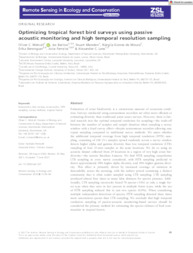Optimizing tropical forest bird surveys using passive acoustic monitoring and high temporal resolution sampling.
Optimizing tropical forest bird surveys using passive acoustic monitoring and high temporal resolution sampling.
Autoria: METCALF, O. C.; BARLOW, J.; MARSDEN, S.; MOURA, N. G. de; BERENGUER, E.; FERREIRA, J. N.; LEES, A. C.
Resumo: Estimation of avian biodiversity is a cornerstone measure of ecosystem condition. Surveys conducted using autonomous recorders are often more efficient at estimating diversity than traditional point-count surveys. However, there is limited research into the optimal temporal resolution for sampling-the trade-off between the number of samples and sample duration when sampling a survey window with a fixed survey effort-despite autonomous recorders allowing easy repeat sampling compared to traditional survey methods. We assess whether the additional temporal coverage from high temporal resolution (HTR) sampling, consisting of 240 15-s samples spread randomly across a survey window detects higher alpha and gamma diversity than low temporal resolution (LTR) sampling of four 15-min samples at the same locations. We do so using an acoustic dataset collected from 29 locations in a region of very high avian biodiversity-the eastern Brazilian Amazon. We find HTR sampling outperforms LTR sampling in every metric considered, with HTR sampling predicted to detect approximately 50% higher alpha diversity, and 10% higher gamma diversity. This effect is primarily driven by increased coverage of variation in detectability across the morning, with the earliest period containing a distinct community that is often under sampled using LTR sampling. LTR sampling produced almost four times as many false absences for species presence. Additionally, LTR sampling incorrectly found 70 species (34%) at only a single forest type when they were in fact present in multiple forest types, while the use of HTR sampling reduced this to just two species (0.9%). When considering multiple independent detections of species, HTR sampling detected three times more uncommon species than LTR sampling. We conclude that high temporal resolution sampling of passive-acoustic monitoring-based surveys should be considered the primary method for estimating the species richness of bird communities in tropical forests.
Ano de publicação: 2022
Tipo de publicação: Artigo de periódico
Unidade: Embrapa Amazônia Oriental
Palavras-chave: Ave Selvagem, Bioacustica, Floresta Tropical, Tropical forests
Observações
1 - Por padrão são exibidas publicações dos últimos 20 anos. Para encontrar publicações mais antigas, configure o filtro ano de publicação, colocando o ano a partir do qual você deseja encontrar publicações. O filtro está na coluna da esquerda na busca acima.
2 - Para ler algumas publicações da Embrapa (apenas as que estão em formato ePub), é necessário ter, no celular ou computador, um desses softwares gratuitos. Sistemas Android: Google Play Livros; IOS: iBooks; Windows e Linux: software Calibre.
Acesse outras publicações
Acesse a Base de Dados da Pesquisa Agropecuária (BDPA) para consultar o acervo completo das bibliotecas da Embrapa.

